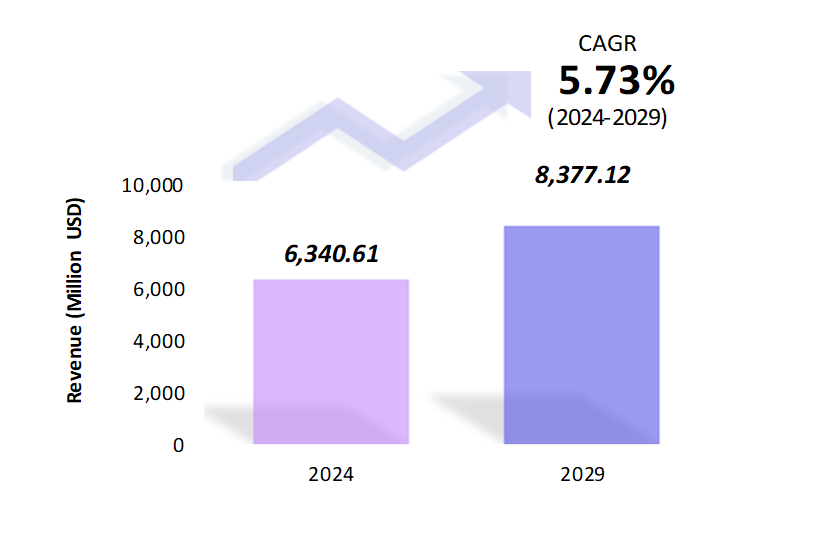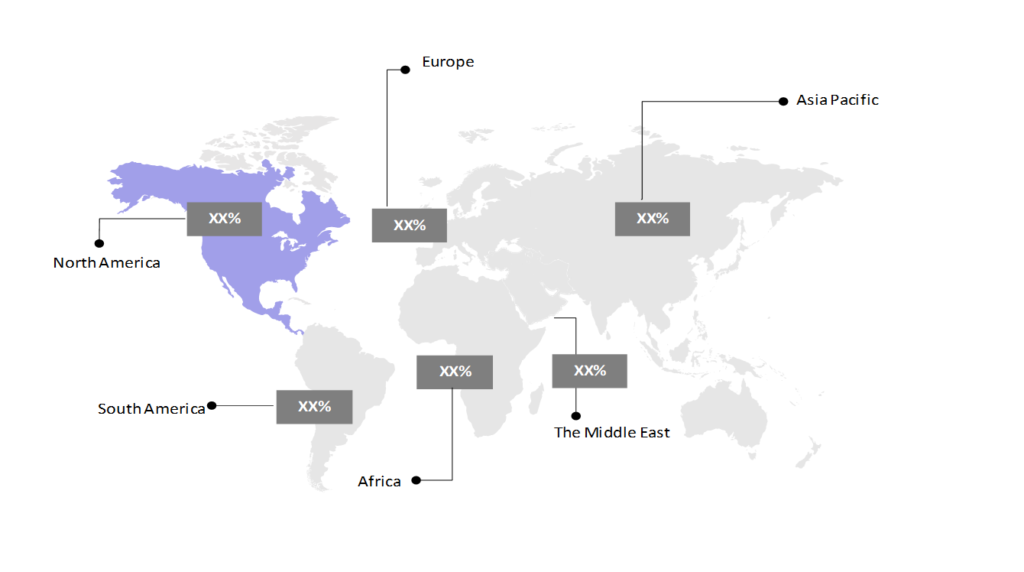Military Transmit and Receive Module Market: Size, Share, Trends & Forecast (2024-2029)
The market report presents a thorough analysis segmented by Type (Gallium Nitride, Gallium Arsenide, Others); by Application (Radar, Communication, Electric Warfare, Others); by Geography (North America, South America, Asia Pacific, Europe, The Middle East, Africa).
Outlook

- The military transmit and receive module market is estimated to be at USD 6,340.61 Mn in 2024 and is anticipated to reach USD 8,377.12 Mn in 2029.
- The military transmit and receive module market is registering a CAGR of 5.73% during the forecast period 2024-2029.
- The military transmit and receive module market is growing rapidly due to increased demand for advanced communication systems and defense modernization efforts worldwide. The rise of radar, electronic warfare, and satellite communication systems is driving innovation, especially in materials like gallium nitride (GaN). However, challenges like high costs and vulnerability to radar jamming remain key obstacles.
Request a free sample.
Ecosystem

- The participants in the global military transmit and receive module industry are always developing their strategies to preserve a competitive advantage.
- Apart from established firms, newer players are gaining ground by offering specialized solutions, such as AESA radar and drone countermeasures.
- Several important entities in the military transmit and receive module market include Northrop Gruman Corp.; Thales Group; L3Harris Technologies, Inc.; RTX Corp.; CAES Systems LLC; and others.
Ask for customization.
Findings
| Attributes | Values |
|---|---|
| Historical Period | 2018-2022 |
| Base Year | 2023 |
| Forecast Period | 2024-2029 |
| Market Size (2024) | USD 6,340.61 Mn |
| Market Size (2029) | USD 8,377.12 Mn |
| Growth Rate | 5.73% CAGR from 2024 to 2029 |
| Key Segments | Type (Gallium Nitride, Gallium Arsenide, Other Types); Application (Radar, Communication, Electric Warfare, Others); Geography (North America, South America, Asia Pacific, Europe, The Middle East, Africa) |
| Key Vendors | Northrop Gruman Corp.; Thales Group; L3Harris Technologies, Inc.; RTX Corp.; CAES Systems LLC |
| Key Countries | The US; Canada; Mexico; Brazil; Argentina; Colombia; Chile; China; India; Japan; South Korea; The UK; Germany; Italy; France; Spain; Turkey; UAE; Saudi Arabia; Egypt; South Africa |
| Largest Market | North America |
Get a free quote.
Trends
- Artificial Intelligence (AI) in Communication Systems: AI is transforming military communications by enabling real-time analysis and improved decision-making. AI-driven transmit and receive modules facilitate seamless, secure communication in complex environments, such as naval fleets or drone operations. These AI enhancements ensure that systems adapt quickly to disruptions or cyber threats, maintaining operational integrity.
- Active Electronically Scanned Array (AESA) Radar Innovation: AESA radars are a critical advancement in military transmit and receive modules, which allow for faster, more accurate targeting and situational awareness. This technology improves detection and tracking in dynamic battlefields, providing real-time data on threats. AESA radar systems are lighter and more efficient, which makes them ideal for platforms like fighter jets, helicopters, and drones. Hanwha Systems developed a new AESA radar for light combat aircraft and unmanned aerial systems, significantly enhancing South Korea’s defensive capabilities.
- Gallium Nitride (GaN) Technology: Gallium nitride (GaN) is revolutionizing military transmit and receive modules by enabling higher power and efficiency at higher frequencies. GaN-based modules are especially valuable in radar, electronic warfare, and satellite communications, where fast data transmission and durability are critical. The material’s efficiency reduces the size and weight of equipment, making it highly advantageous in airborne and spaceborne systems. The US Navy leverages GaN technology in its long-range radar systems, which enables enhanced detection of aerial threats like incoming missiles or aircraft from greater distances.
Speak to analyst.
Catalysts
- Development of New Transmit and Receive Module Technologies: Advances in materials are driving the development of next-generation transmit and receive modules. These technologies offer higher efficiency, durability, and power-handling capabilities, crucial for modern military systems. As military forces look for faster, more reliable communication solutions, these innovations help improve radar, electronic warfare, and satellite communications. The development of more compact, lightweight modules also supports their use in drones and other unmanned systems.
- Increase in Demand for Advanced Warfare Communication Systems: As global tensions rise and warfare becomes more technologically complex, the need for advanced communication systems is growing. Military operations today require real-time data transmission, secure communication channels, and reliable systems that can perform in contested environments. New modules enable faster data transfer rates and higher-frequency communication, which are essential for modern combat scenarios such as electronic warfare and cyber operations.
- Focus on Military Modernization: Many countries are investing in military modernization programs, which prioritize upgrading communication infrastructure to meet 21st-century battlefield demands. This involves replacing legacy systems with advanced transmit and receive modules capable of supporting newer platforms like advanced fighter jets, satellites, and naval vessels. For example, the US, China, and South Korea are among the countries heavily focusing on upgrading radar and communication systems to ensure superiority in electronic warfare and information dominance.
Inquire before buying.
Restraints
- Vulnerability to Radar Jamming Techniques: Military transmit and receive modules are vulnerable to radar jamming, a technique where hostile forces deliberately block or distort radar signals, which disrupts critical military communications and surveillance. This poses a significant threat to radar and communication systems, especially in environments with high electromagnetic interference. Electronic warfare systems often target these modules, which necessitates constant advancements to enhance resistance against jamming, but developing foolproof anti-jamming technology remains an ongoing challenge.
- Technical Complexity Associated with T/R Modules: Transmit and receive (T/R) modules are becoming more complex as they integrate advanced technologies like gallium nitride (GaN) and multi-band communication systems. This complexity requires highly skilled expertise in their design, testing, and maintenance, which creates a barrier for adoption, especially in regions with less access to advanced engineering talent. In addition, ensuring compatibility across various military platforms (airborne, naval, and spaceborne) further complicates the deployment of T/R modules.
- High Manufacturing Costs of T/R Modules: The production of military-grade T/R modules involves expensive materials and advanced manufacturing processes that adhere to stringent military standards. This leads to high manufacturing costs, which are a significant barrier for widespread adoption, particularly for smaller defense budgets. The cost of integrating these modules into large-scale systems like radar networks and communication satellites further escalates expenses, which affects overall procurement strategies in military modernization programs.
Personalize this research.
Hotspot

Explore purchase options.
Table of Contents
| 1. Introduction 1.1. Research Methodology 1.2. Scope of the Study 2. Market Overview / Executive Summary 2.1. Global Military Transmit and Receive Module Market (2018 – 2022) 2.2. Global Military Transmit and Receive Module Market (2023 – 2029) 3. Market Segmentation 3.1. Global Military Transmit and Receive Module Market by Type 3.1.1. Gallium Nitride 3.1.2. Gallium Arsenide 3.1.3. Other Types 3.2. Global Military Transmit and Receive Module Market by Application 3.2.1. Radar 3.2.2. Communication 3.2.3. Electric Warfare 3.2.4. Others 4. Regional Segmentation 4.1. North America 4.1.1. The US 4.1.2. Canada 4.1.3. Mexico 4.2. South America 4.2.1. Brazil 4.2.2. Argentina 4.2.5. Rest of South America 4.3. Asia Pacific 4.3.1. China 4.3.2. India 4.3.3. Japan 4.3.4. Rest of Asia Pacific 4.4. Europe 4.4.1. The UK 4.4.2. Germany 4.4.3. Italy 4.4.4. Rest of Europe 4.5. The Middle East 4.5.1. Turkey 4.5.2. UAE 4.5.3. Rest of the Middle East 4.6. Africa 4.6.1. Egypt 4.6.2. South Africa 4.6.3. Rest of Africa 5. Value Chain Analysis of the Global Military Transmit and Receive Module Market 6. Porter Five Forces Analysis 6.1. Threats of New Entrants 6.2. Threats of Substitutes 6.3. Bargaining Power of Buyers 6.4. Bargaining Power of Suppliers 6.5. Competition in the Industry 7. Trends, Drivers and Challenges Analysis 7.1. Market Trends 7.1.1. Market Trend 1 7.1.2. Market Trend 2 7.1.3. Market Trend 3 7.2. Market Drivers 7.2.1. Market Driver 1 7.2.2. Market Driver 2 7.2.3. Market Driver 3 7.3. Market Challenges 7.3.1. Market Challenge 1 7.3.2. Market Challenge 2 7.3.3. Market Challenge 3 8. Opportunities Analysis 8.1. Market Opportunity 1 8.2. Market Opportunity 2 8.3. Market Opportunity 3 9. Competitive Landscape 9.1. Northrop Gruman Corp. 9.2. Thales Group 9.3. L3Harris Technologies, Inc. 9.4. RTX Corp. 9.5. CAES Systems LLC 9.6. Company 6 9.7. Company 7 9.8. Company 8 9.9. Company 9 9.10. Company 10 |
Know the research methodology.
Military Transmit and Receive Module Market – FAQs
1. What is the current size of the military transmit and receive module market?
Ans. In 2024, the military transmit and receive module market size is USD 6,340.61 Mn.
2. Who are the major vendors in the military transmit and receive module market?
Ans. The major vendors in the military transmit and receive module market are Northrop Gruman Corp.; Thales Group; L3Harris Technologies, Inc.; RTX Corp.; CAES Systems LLC.
3. Which segments are covered under the military transmit and receive module market segments analysis?
Ans. The military transmit and receive module market report offers in-depth insights into Type, Application and Geography.
